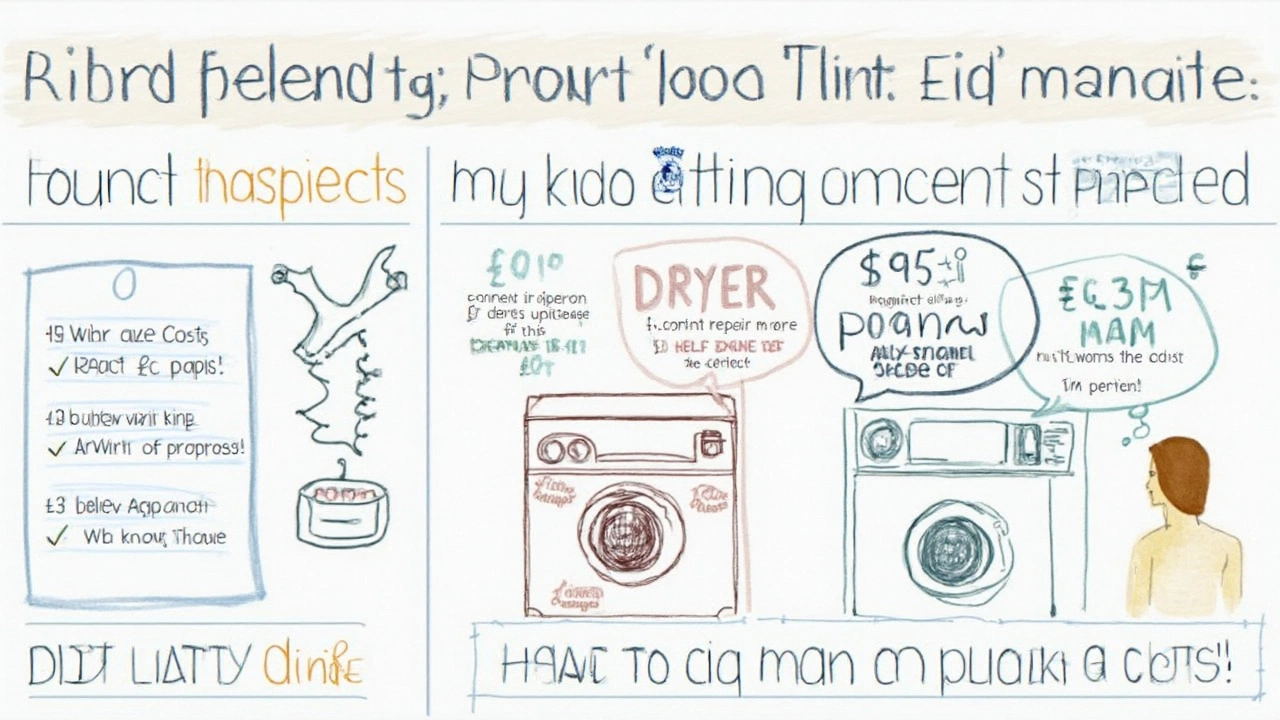Ever had that irritating moment when you’re fishing out clothes that are still damp after an hour? Or maybe your dryer is making that screeching sound that’s impossible to ignore. If your dryer’s causing trouble, it’s easy for frustration to set in, but before you start panic-buying a replacement, take a pause. This is more common than you think—across the US, over 20 million homes rely on a dryer every week, and appliance repair shops get swamped with calls for help, especially after the holidays. There’s no one-size-fits-all answer when it comes to whether fixing a dryer is worth it, but you can get close if you break it down by facts, not just feelings.
Understanding Dryer Problems: Is It a Minor Glitch or a Money Pit?
Dryers are like used cars—sometimes you just need a quick fix, but other times, things are falling apart under the hood. The first step is figuring out exactly what’s going on. Some problems are notorious for being cheap and painless to fix. For example, a blown thermal fuse or a busted belt usually costs under $30 to DIY, and even if you hire a pro, it often runs under $100. On the flip side, if the motor’s toast or it needs a new control board, you could be looking at a $250–$400 bill if you go through an appliance repair company. That’s about half the price of a new, middle-range machine.
Here’s a quick cheat sheet of famous dryer issues, what they might mean, and how much they could cost you if you hire out the work:
- Clothes not drying: Clogged lint trap or vent ($0–$50), heating element gone bad ($120–$250).
- Loud squeaking/howling: Worn drum support rollers or idler pulley ($60–$150).
- No power at all: Bad starter switch or blown fuse ($70–$200).
- Drum not spinning: Broken belt ($80–$200 with labor), seized motor (upwards of $300).
If your dryer was a budget buy to begin with and is over seven years old, those big-ticket repairs tip the scales toward replacement. But if your machine is a known workhorse—think mid-range Samsung, Whirlpool, LG, or Maytag—you might eke out several more years with a $150 fix. A simple trick: If the repair estimate is more than half of what a new, similar dryer would cost after taxes and delivery, it’s usually smarter to put the money toward a replacement. That rule comes straight from professional appliance techs, who see these decisions every day.
It’s rarely worth fixing if your machine has a cracked drum (that escalates fast) or if you’re dealing with repeated electrical problems that leave you worried about safety. Water in the base or corrosion around the frame is a sign it’s past its prime. But don’t jump the gun—sometimes a wonky dryer just needs its vent cleaned or a new door switch, and you’re back in business for the price of a nice dinner.
The Real Cost of Repair vs. Replacement: What Will You Actually Spend?
Let’s call it what it is: Money makes the decision for a lot of us. There’s a wild range in what you’ll actually pay for repairs depending on where you live, the brand you chose, and the age of your dryer. Calling out a pro just to diagnose your dryer usually lands you with a $60–$120 fee, but that’s often rolled into the total repair bill if you say yes to the fix. When you’re quoted $250 for a new motor in an eight-year-old machine, you have to ask—does it still make sense? New dryers from big-box stores run $400–$1,200 (not counting delivery or haul-away fees). They also come with fresh warranties and energy-saving tech.
Here’s something homeowners overlook: the hidden costs of shopping for a new dryer. Besides the sticker price, you cough up for delivery (often $75–$100), hauling away the old deadbeat ($25–$50), a new vent kit ($20–$30), and sometimes even modifications to your laundry hookup. Not the simple swap you’d hoped for, huh? But there’s a silver lining: Newer dryers sip less electricity (up to 25% less if you choose an Energy Star model) and tend to be gentler on clothes.
Let’s break down the math. If your trusty dryer only needs a $110 heating element replacement, you spend far less than shelling out $700 on something new. If you get hit with a $350 motor repair but dread the idea of shopping, you have to weigh how long that fix will hold up. If a professional repair stretches your dryer’s life three more years, does that make it worth it? Appliance experts say if your machine is less than ten years old, doesn’t have a history of breakdowns, and the repair is under $300, go for the fix. Once you cross that ten-year mark, though, repairs are more like duct tape—temporary and not always trustworthy.
For those thinking DIY might be the way out: Swapping a fuse, a belt, or rollers is surprisingly straightforward (a YouTube video or manufacturer’s guide can walk you through). Just shut off the power first—no one wants to end up as a viral cautionary tale. You can save $100–$200 in labor this way, and you’ll get a sense of accomplishment, too.
Be wary of "throwaway" models—cheap brands or those with hard-to-find parts (like old Kenmore models or rare Euro imports) may leave you stranded when they fail. If your machine is pushing twelve years, has a dodgy track record, or replacement parts take weeks to arrive, your money is almost always better spent on a replacement. Don’t pay for frustration.

Common Fixes and How They Stack Up: DIY, Pros, and Red Flags
Not every dryer repair needs a tech in a branded van. Plenty of fixes are in reach for regular folks with Google and a screwdriver. Some of the most common dryer snags—like a broken belt, a clogged vent, or a worn idler pulley—are easier than changing the oil in your car. Genuine parts are available on Amazon or straight from appliance stores, and swapping them usually takes 30–60 minutes if you don’t mind a little dust. Here’s where you get the most bang for your buck with a DIY approach:
- Dryer belt replacement: You’ll need to pop off the front or rear panel. A replacement belt costs $10–$25; many people have their dryer spinning again within an hour.
- Thermal fuse swap: If your dryer won’t heat, this $10–$20 fuse is often the culprit. Just unplug, unscrew, pop in the new one.
- Vent cleaning: Your vent hose is lint’s favorite playground. Every year, this alone causes thousands of house fires. Pull the dryer out, detach the hose, and run a cleaning brush through (you can buy the kit for under $20). This fix can transform a slow dryer and keep the fire department away.
- Drum roller or idler pulley: A squeal usually means these are shot. Replacements run $15–$30, and YouTube’s full of step-by-step videos for almost every model.
When should you call in the pro? Big repairs like replacement motors, broken electronic boards, or major drum issues need a tech (unless you love tinkering). Branded control boards can cost $150–$350 before labor, and a misstep can toast your new part. Also, sometimes you just want someone else to handle the hassle—nothing wrong with paying for peace of mind!
Big red flags: If dryer repairs come in waves—fix one thing, another breaks next month—it’s a sign the machine is on its last legs. If your machine has rust, torn seals, or obvious water damage, those minor repairs won’t fix the deeper problems. And if you notice odd electrical smells or scorched parts near the wires, unplug it and walk away. Better safe than sorry.
Don’t forget to check for recalls! Some models from Samsung, LG, Whirlpool, and other brands have had recall notices for fire risk, overheating, or defective parts. Pop your model number into the manufacturer’s site or saferproducts.gov. If your machine’s on the list, you might actually get a free fix or replacement even if it’s old.
How to Decide: Dryer Repair Hacks, Money-Saving Tips, and When to Say Goodbye
No one likes shelling out for a big appliance, but it’s even worse dropping cash on a fix that doesn’t last. If you want to avoid regret, here’s a playbook that helps:
- Get a quote before you commit. The diagnosis fee usually rolls into the repair if you say yes—but say no? You’re only out the service call.
- Check the price of repairs against the "half-the-cost-of-new" rule. If repairs are cheap and the machine hasn’t had a history of drama, grab a wrench.
- Factor in age and brand. Mid-range and high-end models, especially from dryer repair kings like Whirlpool, Maytag, and LG, are workhorses. If your dryer’s under 10 and hasn’t failed before, it probably merits another shot.
- Do the DIY fixes first. Cleaning out lint, swapping belts, or switching out fuses usually costs less than movie tickets and pays back big.
- Read the warranty. A lot of folks forget their dryer may still be covered for parts, labor, or specific components. Even a one-year extended warranty can help make the call.
- If the machine is more than twelve years old—just walk away. You’re entering endless money pit territory after a decade of life for most dryers.
Want to make your next dryer last? Make it a habit to clean the lint trap after every spin. Every few months, give that vent hose a proper cleaning. It’s boring, but it makes a huge difference in how your appliance runs. Don’t cram wet laundry in all at once and avoid running it back-to-back for hours—your motor and heating element will thank you.
Smart shoppers watch for sales around holidays (Presidents’ Day, Memorial Day, Black Friday), where new dryers take a big price cut. If you’re into used appliances, local repair shops sometimes offer refurbished models with short-term warranties that can bridge the gap for a couple more years if you’re not ready for a big purchase.
Sometimes, the sentimental value of an old workhorse is worth more than the cash. Maybe it dried your kids’ baby blankets, survived three moves, or has just been super reliable but needs a $50 fix. Trust your gut, run the math, don’t rush, and you’ll usually land on the right answer—whether you stick with a repair or treat yourself to something shiny and new.




